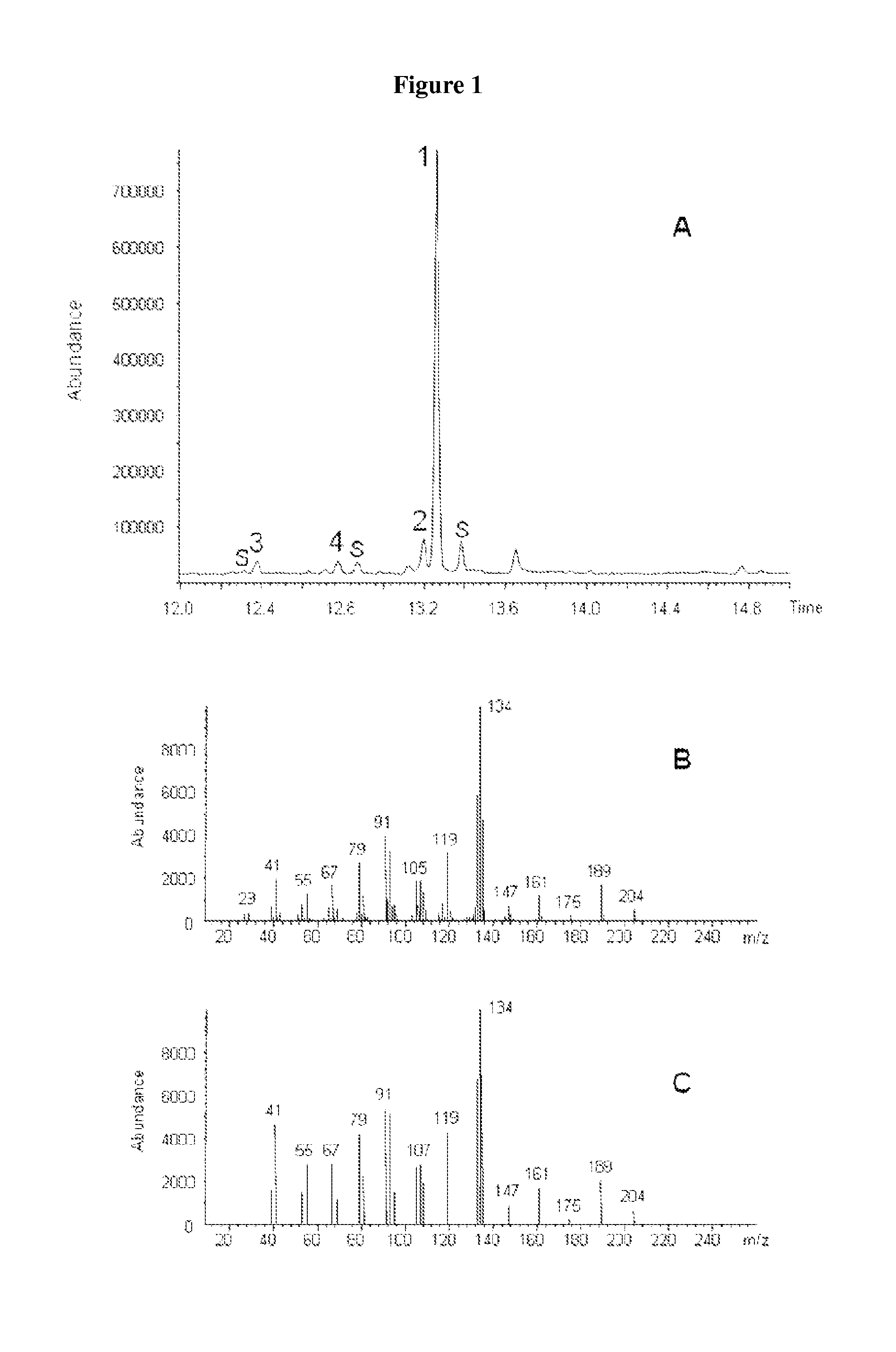Method for producing (+)-zizaene
a technology of zizaene and zizaene, which is applied in the directions of lyase, enzymology, organic chemistry, etc., can solve the problems of difficult or even impossible to make the use of such ingredients in high-quality perfumery very difficult or even impossible some years, and the cost of perfuming ingredients is relatively high, and the purification of oil is not feasible at large scal
- Summary
- Abstract
- Description
- Claims
- Application Information
AI Technical Summary
Benefits of technology
Problems solved by technology
Method used
Image
Examples
example 1
RNA Extraction and cDNA Library Construction
[0136]Vetiver (Vetiveria zizanoides) plants were obtained from a plant nursery (The Austral Plants Company, Les Avirons, The Reunion Island, France). The plants were cultivated in pots in a green house at the Lullier Agronomy research Station (Switzerland) and were propagated vegetatively by dividing six months to one-year-old clumps. For harvesting of the roots, the plants were removed from the pots and rinsed with tap water.
[0137]For preparation of the cDNA library, roots from several plants were combined: young plants (4 to 6 months after propagation), old plants with a well-developed dense root system (1 to 2 years after propagation) and young plants dried at room temperature for 24 to 36 hours after removing them from the pots. The roots were cut off from the aerial part of the plants and frozen in liquid nitrogen. They were first roughly chopped in liquid nitrogen using a Waring Blendor (Waring Laboratory, Torrington, USA) and then g...
example 2
cDNA Library Sequencing and Amplification of a Sesquiterpene Synthase cDNA
[0139]The technology of massive parallel sequencing of small DNA fragments developed by Illumina (San Diego, Calif.) was used to sequence the whole cDNA library. The preparation of the DNA for sequencing, the sequencing and the assembling of the reads were performed by Fasteris SA (Plan-les-Ouates, Switzerland). The cDNA library was treated following the Genomic Sample Prep Kit (Illumina) and sequenced on the Genome Analyzer system (Illumina) A total 4.2 million of 35 bp reads were obtained (of which 3.6 million were unique sequences). These reads were assembled using EDENA 2.1.1, a software finding overlaps between the reads and assembling de novo contigs (Hernandez D., François P., Farinelli L., Øster{dot over (a)}s M., and Schrenzel J., De novo bacterial genome sequencing: Millions of very short reads assembled on a desktop computer. Genome Res. 18(5), 802-809, 2008). After eliminating contigs shorter than ...
example 3
Heterologous Expression and Enzyme Characterization
[0143]The full-length VzZS open reading frame (VzZS-ORF, SEQ ID NO:2) was amplified from the SMART™ 5′ RACE-Ready cDNA pool using the primer ctg306-start (SEQ ID NO:9) and ctg306-stop (SEQ ID NO:10). The amplification of this cDNA for the expression constructs were performed using the Pfu DNA polymerase (Promega, Madison, Wis., USA), in a final volume of 50 μl containing 5 μl of Pfu DNA polymerase 10× buffer, 200 μM each dNTP, 0.4 μM each forward and reverse primer, 2.9 units Pfu DNA polymerase and 2.5 μl of the cDNA (prepared as described above). The thermal cycling conditions were as follows: 1.5 min at 95° C.; 30 cycles of 45 sec at 95° C., 30 sec 54° C. and 4 min at 72° C.; and 10 min at 72° C.
[0144]The PCR products were inserted into the pET101 / D-TOPO vector using the Champion pET101 Directional TOPO Expression Kit (Invitrogen, Carlsbad, Calif.) following the manufacturer's instructions. Several clones were selected and the pla...
PUM
| Property | Measurement | Unit |
|---|---|---|
| optimal temperature | aaaaa | aaaaa |
| optimal temperature | aaaaa | aaaaa |
| optimal temperature | aaaaa | aaaaa |
Abstract
Description
Claims
Application Information
 Login to View More
Login to View More - R&D
- Intellectual Property
- Life Sciences
- Materials
- Tech Scout
- Unparalleled Data Quality
- Higher Quality Content
- 60% Fewer Hallucinations
Browse by: Latest US Patents, China's latest patents, Technical Efficacy Thesaurus, Application Domain, Technology Topic, Popular Technical Reports.
© 2025 PatSnap. All rights reserved.Legal|Privacy policy|Modern Slavery Act Transparency Statement|Sitemap|About US| Contact US: help@patsnap.com



